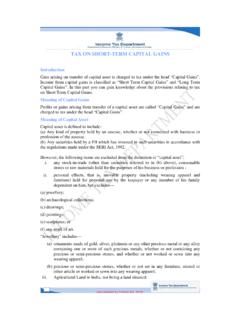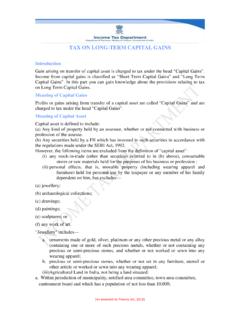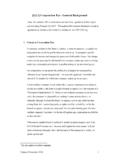Transcription of Ashok Raghavan Chartered Accountant Bangalore
1 1 ISSUES ON capital GAINS ON TRANSFER OF IMMOVABLE PROPERTIES Ashok Raghavan Chartered Accountant Bangalore I. INTRODUCTION: The topic Income from capital Gains is very vast in nature and requires a thorough understanding of the provisions of Section 45 Section 55A, Section 2(47) which defines the term transfer , Section 2(14) which defines the term capital Asset , Section 2(29A) which defines the term Long Term capital Asset and Section 2(42A) which defines the term Short Term capital Asset . Consequential definitions of certain terms namely Long Term capital gain as enumerated under Section 2(29B) and Short Term capital gain as defined in Section 2(42B) should also be looked into.
2 A clear understanding of the definition of the term Transfer under Section 2(47) of the Income tax act and the definition of the term Immovable Property under Section 269UA(d) of the Income tax act becomes essential to understand the consequences arising out of the retention and transfer of immovable property and the tax incidence thereon. 1) Transfer under Section 2(47) includes: i) the sale , exchange or relinquishment of the asset; or ii) the extinguishments of any rights therein; or iii) the compulsory acquisition thereof under any law; or iv) in a case where the asset is converted by the owner thereof into, or is treated by him as, stock-in-trade of a business carried on by him, such conversion or treatment; or iva) the maturity or redemption of a Zero Coupon Bond; or 2 v) any transaction involving the allowing of the possession of any immovable property to be taken or retained in part performance of a contract of the nature referred to in section 53A of the Transfer of Property Act, 1882 (4 of 1882).
3 Or vi) any transaction (whether by way of becoming a member of, or acquiring shares in, a co-operative society, company or other association of persons or by way of any agreement or any arrangement or in any other manner whatsoever) which has the effect of transferring, or enabling the enjoyment of any immovable property; Explanation: For the purposes of sub-clauses (e) and (f), Immovable Property shall have the same meaning as in clause (d) of Section 269UA of the Income tax act . 2) Immovable Property under Section 269 UA (d) means: (i) any land or building or part of a building, and includes, where any land or any building or part of a building is to be transferred together with any machinery, plant, furniture, fittings or other things, such machinery, plant, furniture, fittings or other things also. Explanation: For the purposes of this sub-clause, land, building, part of a building, machinery, plant, furniture, fittings and other things include any rights therein; (ii) any rights in or with respect to any land or any building or a part of a building (whether or not including any machinery, plant, furniture, fittings or other things therein) which has been constructed or which is to be constructed, accruing or arising from any transaction (whether by way of becoming a member of, or acquiring shares in, a co-operative society, company or other association of persons or by way of any agreement or any arrangement of whatever nature), not being a transaction by way of sale, exchange or lease of such land, building or part of a building; The said definition has been linked to the explanation under Section 2(47) of the Income tax act as mentioned above.
4 3 II. CHARGEABILITY OF capital GAINS: The power to levy capital gains is enshrined in the provisions of Section 45 of the Income tax act , which states as follows: Any profits or gains arising from the transfer of a capital asset effected in the previous year shall, save as otherwise provided in Sections 54, 54B, 54D, 54E, 54EA, 54EB, 54F, 54G and 54H be chargeable to income-tax under the head capital gains and shall be deemed to be the income of the previous year in which the transfer takes place . From the aforesaid definition it is clear that there should be (i) Profits and gains from (ii) the transfer (iii) of a capital asset for the purpose of invoking the provisions of Section 45(1). Many issues of considerable importance emerge on the taxation of Income from capital Gains mainly due to the complex definition of the term transfer and the term capital asset and some of such issues which are restricted to the capital Gains arising out of the transfer of immovable properties are highlighted below: III.
5 ISSUES ARISING ON TRANSFER OF IMMOVABLE PROPERTY. 1. SALE OF LAND AND BUILDING UNDER COMPOSITE AGREEMENT It is often observed that both the land and building are sold under one composite agreement for a lump sum consideration without assigning the individual value for each of them. Further in case where the land is considered as a long term capital asset and the building as a short term capital asset due to the respective periods for which such assets were held, it becomes difficult to ascertain the amount taxable as long term and short term capital gains respectively. Therefore in all such cases, it is always better 4 to clearly mention the value for land and building separately in the instrument of conveyance. It has clearly been held in the cases mentioned below that where the land has been held for the period of more than 36 months and the building for less than 36 months, the capital gains will be taxed as long term and short term respectively.
6 Refer: CIT Vs Vimal Chand Golecha 201 ITR 442 (Raj) CIT Vs Rao 236 ITR 51 (Mad) CIT Vs Subramanian(2000)242 ITR 342(Kar) CIT Vs Estate Of Omprakash Jhunjhunwala(2002)254 ITR153(Cal) The Statesman Ltd v (2007)295 ITR(AT)388(Kol-Trib) 2. DEDUCTION OF LIABILITY ATTACHED TO PROPERTY (i) In many cases immovable properties are purchased by borrowing funds for the purpose. Subsequently when the immovable property is sold, the owner of the immovable property generally clears the liability due to the lender so that the lender releases the documents of title to the borrower to enable him to sell the immovable property. However, it is to be noted that although the amount ultimately received by the owner is after paying the liability, the entire amount received for the same will be taken as the consideration for sale for the purpose of levy of capital gains, , in other words, the liability repaid by the assessee from the sale proceeds cannot be reduced from the consideration for the computation of capital gains.
7 In other words in case of self created mortgage the amount paid to discharge the liability due to the mortgagee cannot be added to the actual cost nor can be reduced from the sale consideration. Refer: - Vs CIT 227 ITR 222 (1997) (SC) (ii) Where the property was mortgaged to the government and thereby interest in property was created in favour of the government, when such property is sold the interest that was created in favour of the government by mortgage could be reduced from the sale price of the property sold by public auction. The analogy adopted by the court in this case was that there is a diversion of income by 5 overriding title in favour of the government and therefore the amount received directly by the government could not be taken as consideration received by the assessee for the purpose of computation of capital gains. Refer: CIT Vs Attili Narayana Rao (1998) 233 ITR 10 (AP) However the Supreme Court has reversed the judgment of the High Court by holding that the liability paid to the Government cannot be reduced from the sale consideration payable to the assessee as per the document of conveyance.
8 The aforesaid decision of the Supreme Court further elaborates the point that the liability towards a self created mortgage cannot be reduced from the sale consideration as held in the case of (supra). Refer: CIT Vs Attili Narayana Rao (2001) 252 ITR 881 (SC) CIT Vs Roshanbabu Mohammed Hussein Merchant 275 ITR 231(Bom) (iii) Where a mortgage was created by the previous owner during his life time and the same was subsisting on the date of his death, the successor obtains only the mortgagor s interest in the property and by discharging the mortgage debt he acquires the mortgagee s interest in the property and therefore, the amount paid to clear off the mortgage is the cost of acquisition of the mortgagee s interest in the property which is deductible as cost of acquisition under Section 48. Refer: Jagadishchandran, Vs. CIT (1997) 227 ITR 240(SC) Naidu Vs.
9 ITO (1989) 28 ITD (MAD TRI) 3. CONVERSION OF capital ASSETS INTO STOCK-IN-TRADE(SECTION 45{2}): Conversion by the owner of a capital asset into stock-in-trade or treatment by him of such asset as stock-in-trade of business carried on by him will be taxable as follows: - Fair Market Value of the capital asset on the date of conversion minus the value shown in the books will be charged as income from capital gains 6 - The difference between sale value and the Fair Market Value as on the date of conversion will be charged under the head profits and gains from business and profession. The incidence of tax on capital gains and business profit will arise only in the year when such stock in trade is sold or otherwise transferred. The Kolkata Tribunal in the case of Octavius Steel and Company limited vs ACIT (2002)83 ITD 87 has held that Section 45(2) supersedes all the provisions including Section 45(1) and provides for charging of capital Gains in the year when such converted stock in trade is sold or otherwise transferred.
10 Therefore, it is obviously better to ensure that the Fair Market Value as on date of conversion is on the higher side as the tax rate on capital gain is much less than that on business income. Further the indexation benefit is available on the capital gains. However, if the assessee has got carry forward business loss or unabsorbed depreciation from any business being carried on or which was carried on by him, it is better to reduce the Fair Market Value on date of conversion so that the business profit becomes more. It is be noted that the proviso to Section 72(1)(i) which provided that the business in which the carry forward loss arose should be carried on in the year of set off was removed with effect from 01/04/2000. SECTION 45 (2) VIS- -VIS SECTION 50 C It is to be noted that when a capital asset gets converted into stock in trade, it ceases to be a capital asset and hence the provision of Section 50 C will not be applicable.










